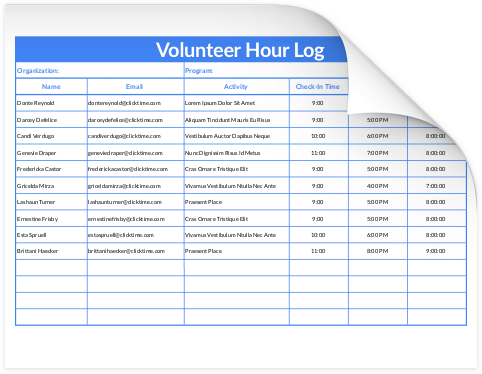Why Your Nonprofit Should Be Tracking Volunteer Time
Table of Contents
Do you know the value of your nonprofit’s volunteer time?
As a nonprofit employee, you’re well aware of the importance of volunteers and the hours they give to your organization. Without them, you couldn’t run your programs as smoothly or give as much back to your community.
5 Reasons for Tracking Volunteer Time
Win Competitive Grants
Show Community Support
Show the True Cost of Your Programs
View Your Nonprofit’s Impact
Attract More Volunteers
Volunteers’ time is indisputably invaluable. However, nonprofits do themselves — and their volunteers — a disservice when they refrain from assigning a concrete value to their time.
Understanding the monetary value of volunteering can help nonprofits better articulate their community impact and earn more funding. With more funding, nonprofit organizations can do more work toward their mission — and attract more volunteers who are eager to help a worthy cause.
To calculate how much your volunteer time is worth, you can use the estimated national value of a volunteer hour: a little over $28, as of 2020. But you also need to know how much time your volunteers actually spend working with your nonprofit.
To understand the true value of your volunteers, you need to start tracking volunteer time.
5 Reasons for Tracking Volunteer Time
You might think that tracking volunteer time involves a lot of unnecessary work. You have to set up a kiosk or put out a form for logging volunteer hours.

Download your free volunteer hour log template to start tracking volunteer time.
While relying on estimates and educated guesses is easier than actually tracking volunteer time, it doesn’t help your nonprofit in the long run. To understand the true value of your volunteers’ efforts — and the true impact they and your nonprofit have on your community — you need to start tracking the time they give to you.
Keep reading to understand the multiple benefits your nonprofit can experience by tracking volunteer time.
1
It Can Help You Win Competitive Grants
Many grantmakers require that a nonprofit have matching funds before they can qualify for grant funding. And many funders will count volunteer time against matching requirements. So if your nonprofit is applying for grants — or wants to — you definitely need to start tracking the hours your volunteers spend working with you.
When you know how many hours of volunteer time you have (or how many you plan to dedicate to a program) you can convert those hours to dollars. You can then include the value of your volunteer time as an in-kind donation in your grant budget. That takes some of the pressure off your fundraising team to meet high match requirements for competitive funding by simply calculating the overall value of your volunteer time.
But even if there is no matching requirement, showing the value of your nonprofit’s volunteer time can improve your chances of funding.That’s because funders like to know that nonprofits can rely on resources of their own to keep programs running. And as Marc Lewis, executive editor at environmental news site Ecowatch mentions, “The greater the donation or contribution, the better the application will look in the eyes of the funder.”
The takeaway: When you track volunteer time, you can understand the exact value of your organization’s combined volunteer hours. Knowing this monetary value can help you meet matching requirements or give funders an idea of what your organization could do with more resources.
2
It Shows Your Nonprofit Has Community Support

Even if you’re not applying for competitive grants, your nonprofit will always be seeking funding. That’s just the nature of nonprofit finance. Tracking volunteer time is one of the best ways to prove to potential funders that your cause already has support from other community members.
Lewis points out that “funders love to fund programs with high community engagement. And, he adds, “the easiest and most objective measure of community engagement is how many volunteers are involved in a nonprofit or specific charitable program.”
In this case, you don’t even need to calculate the monetary value of your volunteer time. Although, it probably doesn’t hurt to include it as a line item in your funding application. Simply showing your nonprofit can organize manpower behind your cause can demonstrate to funders that people already believe in your mission.
The takeaway: High engagement shows your organization can generate support, with or without a funder. But if a funder does decide to give you money, they know your organization can mobilize people to use their funding effectively.
3
It Shows the True Cost of Your Programs
If every volunteer in America quit showing up, the nation would lose over $180 billion in time and effort.
While your organization’s volunteers are only a small piece of those billions of dollars, losing the labor donated by volunteers would be a significant financial blow to your organization. And that’s important to understand when calculating what the true cost of your programs would be without volunteer work.
Converted to a typical 40-hour workweek, that would require an additional two full-time employees for each nonprofit each year. At an average salary of $58,000 per year, that would cost each nonprofit in America an additional $125,000. And that’s before factoring in the $50,000 in combined benefit costs for each of those employees.
For most nonprofits, that’s a huge additional expense to cover. But since this labor is provided by volunteers, your organization can instead save that $175,000 — or whatever the cost of a full-time employee would be to cover volunteer hours at your nonprofit — and invest it directly into programs.
Understanding what your programs would cost to undertake without volunteers helps you create better contingency plans for the future. Because the idea of every volunteer in America quitting tomorrow isn’t exactly unrealistic: nearly 66% of volunteers decreased or ceased their volunteering due to the COVID-19 pandemic.
I’ll refrain from walking you through the calculations, but using the same numbers from our math problem above, we come up with these staggering figures for how COVID-19 disrupted volunteering for nonprofits:
- A loss of over 2,000 hours of volunteer labor, worth over $85,000
- A potential additional cost of over $100,000 per nonprofit to cover the salary and benefits of full-time employees to make up the difference in hours worked for the nonprofit
The takeaway: The true cost of a program, including volunteer hours, is of course important information for funders or board members. But it’s especially important when considering how you’ll grow your nonprofit — during and despite hard times. If or when volunteers can’t donate their time, your nonprofit will know how much it would cost to keep your programs running at the same capacity.
4
It Paints a More Complete Picture of Your Nonprofit’s Impact

Calculating the labor value of your volunteers by tracking their hours can help showcase your nonprofit’s impact in the community. It can also help illustrate the benefits the community receives from the work your volunteers do.
If your volunteers decreased their hours, for example, community members might receive fewer services.
When you know how much time volunteers spend performing certain services, you can demonstrate several points:
- How much of an impact your volunteers make through the provision of services
- What these services would cost community members if they had to seek these services elsewhere or forego them entirely
- How much the community saves (in time or in dollars) by receiving these services through your nonprofit
It’s important to answer these questions for donors, who will want to understand why they should donate to your organization over others. But it’s also important to show how effective your nonprofit is in achieving its mission. If you’re not providing services at a lower cost (in time or money) for community members, then you should reevaluate your program.
From another angle, tracking volunteer time also helps you understand, internally, where your volunteers are making the most impact. Knowing in which programs or activities your volunteers are most effective can help your nonprofit make data-based decisions about where to invest more time or training.
On the one hand, if a volunteer program has high engagement, you can attempt to amplify that engagement through more training and interaction with volunteers. On the other hand, if you’re seeing low engagement in a volunteer program, you can make objective decisions about how to improve it, change it, or even axe it entirely.
The takeaway: Tracking volunteer time is critical for measuring the true impact of your programs and of your nonprofit overall. When you understand the value of your volunteers’ time for the community and your organization, you can make objective decisions about how to use that time effectively.
5
It Helps You Attract More Volunteers

Tracking volunteer hours can kick off a very beneficial cycle for your nonprofit.
You can encourage engagement with your nonprofit by tying hours directly to rewards for volunteers. For example, I took improv classes at a nonprofit improv theater. Classes could be pricey, so the theater agreed to discount tuition based on their total volunteer hours. While the organization technically lost tuition money, they gained valuable services (for free) from volunteers who filmed shows and welcomed guests.
Students were motivated to keep volunteering because their classes were cheaper. And they were encouraged to continue taking classes from the theater because their accumulated volunteer hours gave them a discount.
But even if you don’t tie hours directly to rewards, volunteers can still benefit from time tracking.
Will Peach, a medical student at Medical University Varna, points out that volunteer experience is critical for med school applicants. He says, “If volunteers know their hours are getting tracked, they will be more keen to volunteer and give their time or service. The fact that they can present hard data to a school (or to potential employers) is something that has massive appeal.”
For students applying to competitive schools, the concrete proof of hours your nonprofit provides could turn a rejection letter into an admissions envelope. One student’s positive experience could encourage others to volunteer for your organization, creating a steady stream of volunteers.
Finally, Jennifer Schultz, an outdoor guide and instructor at Outforia, points out that some volunteers just like to know how much of a difference their time makes. She says that volunteers will feel appreciated when you “recognize their efforts through highlighting certain involvement milestones, or by making it easy for them to obtain a log of the work they've contributed.” She adds, “These gestures also have the additional benefit of helping to build closer communities and increase retention, which is a common challenge for nonprofits.
The takeaway: There are myriad reasons why volunteers will appreciate you tracking their time. However you choose to recognize the time and effort given to you by volunteers, it results in the same benefit for nonprofits: encouraging more volunteering.
Start Tracking Volunteer Hours
Tracking volunteer hours can help you grow your nonprofit. You can use volunteer time data to gain more funding, amplify the impact of your programs, and attract more volunteers for your cause.
To experience the benefits of tracking volunteer time for yourself, you can download our free volunteer hour log template below.
Read more helpful information for nonprofits here:
- Learn why your nonprofit should also track your employees’ hours.
- Learn how tracking nonprofit employees’ time can help your nonprofit save money.
Already tracking employee time? Learn how to write better grant budget proposals so you can secure more funding.
Instant Grant & Fund Reporting. Powerful Program Insights.
Learn how you can keep your funding and goals on track with time tracking software built for nonprofits.




